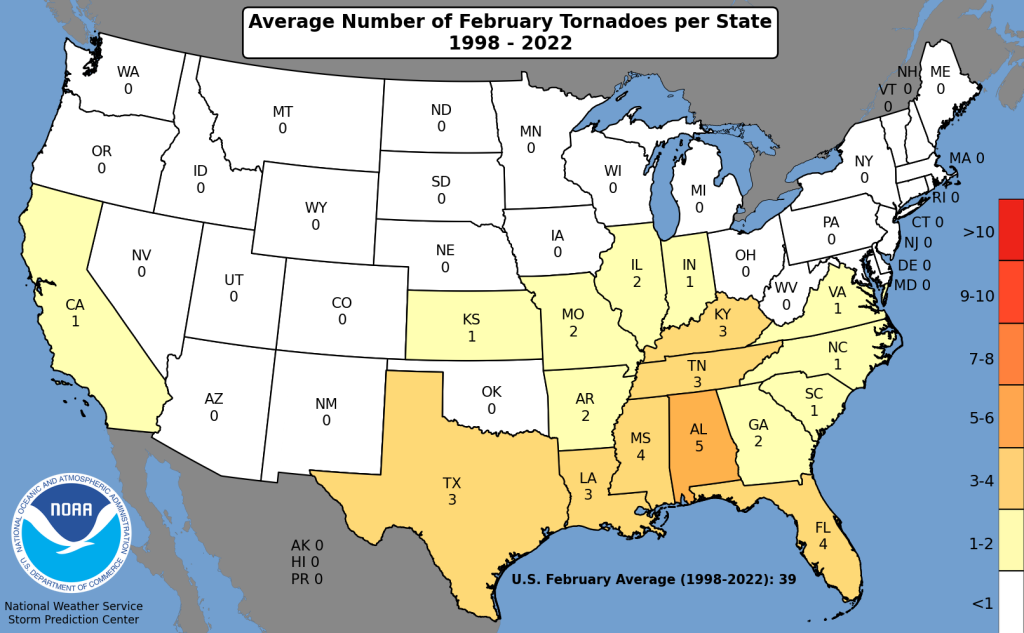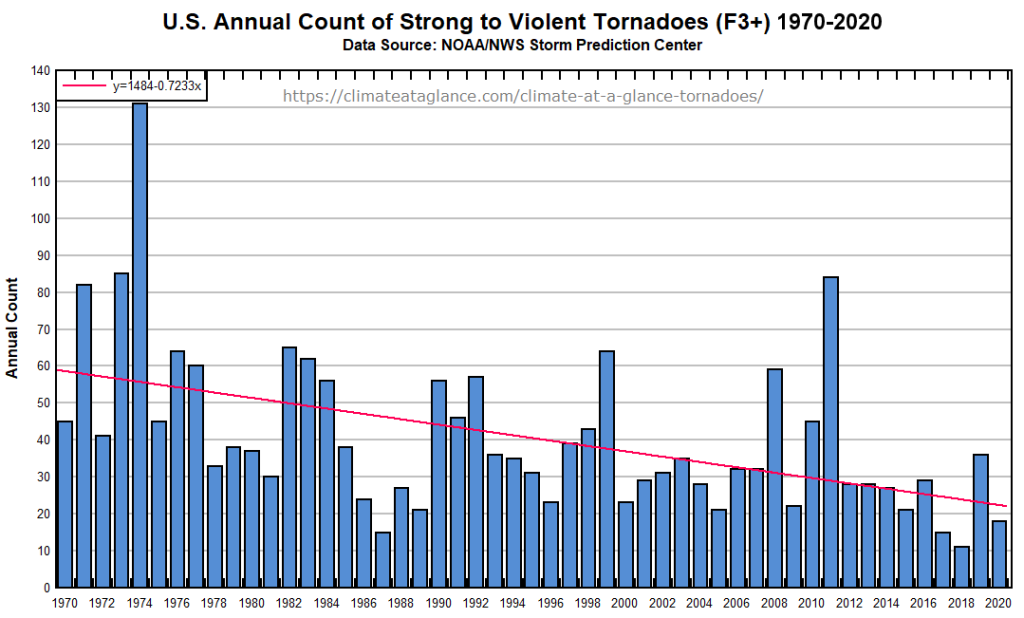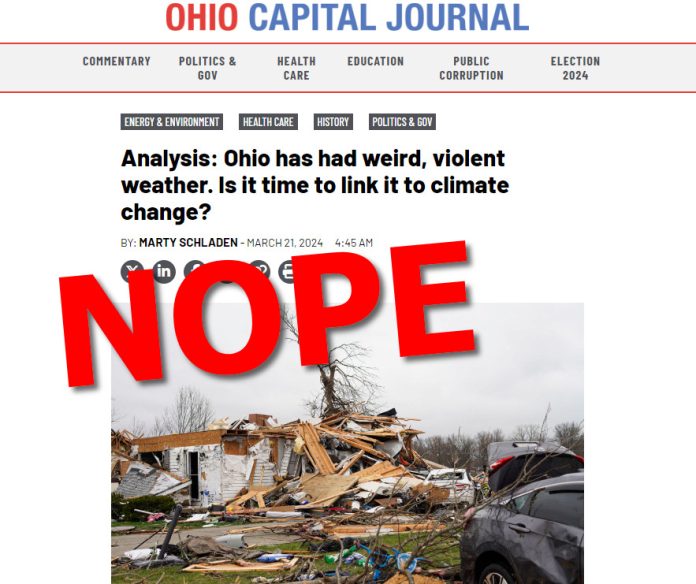An article in the Ohio Capital Journal claims that it’s time to link violent weather to climate change for the state. This is false. There is no real-world evidence showing climate change is weirding the weather in Ohio or anywhere else. Even the latest report from the Intergovernmental Panel on Climate Change (IPCC) does not link changes in severe weather to climate change, or more particularly changes in tornado patterns which the story focuses upon.
The article, written by Marty Schladen is titled, Analysis: Ohio has had weird, violent weather. Is it time to link it to climate change? It begins with these two paragraphs:
For two years running, Ohio has seen what used to be rare February tornadoes, followed by a deadly outbreak just last week. But news coverage of the twisters almost completely omitted any mention of climate change.
With climate scientists overwhelmingly agreeing that human-caused warming is happening and last year having the hottest average global temperature on record, is it time to start linking that to the weird weather we’ve been seeing?
Had Schladen bothered to look at data and the climate science literature, he would have discovered that they show no link between climate change and shifts in the timing or frequency of extreme weather.
First, Schladen errs in believing that two consecutive years of what he considers to be abnormal weather in February is significant. This is not a long enough trend to be considered climate change. It is well established by the World Meteorological Organization that climate change is measured over thirty years not two.
He compounds that error by using one year of warmer than normal temperatures (2023) as the basis for the claim that warmer weather is driving more tornadoes in February. However, data from the National Oceanic and Atmospheric Administration (NOAA) Storm Prediction Center (SPC) indicates that since 1998, there has been a zero trend in Ohio tornadoes for February:

If, in fact, gradually warming temperatures in Ohio due to climate change were driving more tornadoes you would see it in the trend data, but no trend is evident. The February 2023 and 2024 tornadoes in Ohio were rare, but not unique historically. In fact, 17 tornadoes have been recorded in February in Ohio between 1950 and 2016, including some occurring during the period when the Earth was cooling on average from the 1950s through the 1970s. Nor are tornadoes in Ohio becoming stronger. The last F5 tornado recorded in Ohio was in 1985, nearly 40 years of modest warming ago. Data do not support claims that climate change is causing a long-term trend of earlier tornadoes or more extreme tornadoes in Ohio, or anywhere else.
Climate change does not affect individual states like Ohio, it is a much broader phenomenon. Looking at the entire United States over the past 50 years, which has seen a gradual warming, there is also no upward trend for violent tornadoes as seen in Figure 2 below.

Climate at a Glance: Tornadoes reports that the United States has been experiencing a record low number of violent tornadoes in the past decade:
The number of tornadoes in the United States, as well as in other countries, has been slowly declining for the past 45 years. At the same time, the number of strong to violent tornadoes, EF3 or higher, has been dramatically declining for the past 45 years. (See Figure 1.) In fact, the United States set a record in 2017–18 for the longest period in recorded history without a tornado death, and it set a record for the longest period in history (306 days) without an EF3 or stronger tornado.3,4 The two record-low years for tornado strikes in the United States both occurred this past decade, in 2014 and 2018.5
Further, even the U.N. Intergovernmental Panel on Climate Change has acknowledged, “There is low confidence in observed trends in small spatial-scale phenomena such as tornadoes.”
Not only that, a recent peer-reviewed paper, Time trends in losses from major tornadoes in the United States, published in Science Direct in September 2023, shows that U.S. tornado damage & strong tornado incidence are both sharply down. If warming by climate change was driving more tornadoes you would see it in the tornado damage record, but it’s not there.
There is simply no evidence in the data or in climate research supporting the claims made by Schladen. However, if you read the entire piece by Schladen, it becomes obvious that he strays from analysis into opinion, especially when he starts blaming other journalists for not doing their homework, saying:
For journalists covering weather events, it’s easier not to wade into the subject of Earth’s changing atmosphere and whether that has anything to do with the tornado or flood or hurricane or wildfire that they’re trying to cover. In fact, NPR reported in November, weather experts in the Midwest said that talking publicly about global warming brought them threats.
Not mentioning climate in such coverage is also easy to rationalize. No one weather event can be definitely attributed to global warming, many climate scientists have long said.
If Schladen had simply stuck with the last sentence in that excerpt he would have been on target. Instead he lambasts other journalists for being cautious in linking instances of extreme weather events to climate change. They are avoiding, to Schaleden’s displeasure, the error he commits.
The Ohio Capital Journal story is just another instance of sloppy, irresponsible journalism by a reporter promoting his preconceived views on climate change, and the climate catastrophe narrative, over data and facts which don’t fit the narrative.

















Another example of hyperbolic application of extreme weather events to an agenda based on human and fossil fuel caused reasons. Nothing could be further from reality as extreme weather events happen all the time and every place! No statement of long term trends to support such claims. So by that line of reasoning when a normal event occurs it’s due to renewable energy and green technology! How absurd can you be to assume that unless you’re a firm believer in that kind of stuff as there is no logical or historical proof that is true! It’s just more grandstanding and mindless propaganda that sensible people just ignore!